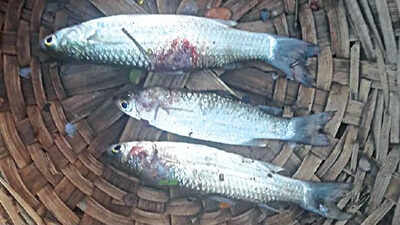Trending
This story is from September 13, 2021
Bacterial infection resurfaces in Goa’s state fish
Goa’s state fish, the mullet continues to suffer from an infection called Epizootic Ulcerative syndrome (EUS) as few specimens with the skin disease surface randomly in the catch in some areas. Compounding this is the lack of continuous research that has concealed the problem.

Organic pollutants, like sewage, are fuelling growth of Pseudomonas, a bacteria that infects skin, gills, the mouth and fins of the fish
PANAJI: Goa’s state fish, the mullet continues to suffer from an infection called Epizootic Ulcerative syndrome (EUS) as few specimens with the skin disease surface randomly in the catch in some areas. Compounding this is the lack of continuous research that has concealed the problem.
This condition affecting mullets and a couple of other estuarine fish species had been reported in the past.“It is purely organic pollutants like sewage which fuel growth of Pseudomonas, a bacteria that infects skin, gills, the mouth and fins of the fish,” Joe D’Souza, a retired professor of Goa University (GU) said.
The microbiologist had studied the first outbreak of EUS with a GU student, S Kudchadkar and had later published the findings.
Fishermen in Mandur have reported scattered incidences of EUS. “Several mullets in the catch have abrasions or bloody patches near the gills and other parts,” Agusto Pereira, a sluice gate operator at Mandur said.
The ulcerative syndrome was reported near prawn hatcheries in St Estevam and Chorao around early 1990s. Pearl spot fish was affected by skin diseases while it also hit the mullet species in Telaulim in Tiswadi, Shiroda in Ponda and Curtorim in Salcete.
The EUS strikes the fish mostly during monsoon when fertilizers and organic run-offs leach into the water and spread out with the flow. The catch looks unfit for consumption and has to be dumped. “The percentage of population affected is not known but it happens mostly in areas where water polluted by industrial and other sources stagnates for longer periods in water bodies,” retired chief scientist, biological oceanography, NIO Baban Ingole said.
In 2014 another episode of pollution triggered by similar conditions caused mass mortality of tisreo (clams) at Musher, Betul.
A three-member team comprising D’Souza and Mahesh Prabhu, a water treatment specialist had conducted a microbiological analysis and found that pollution had lethally impacted the bivalve population. “The bacteria Pseudomonas and fecal coliform together scavenge on the oxygen and render the water anaerobic, suffocating the clams to death,” the study stated.
The study attributed the cause of toxic pollution to massive influx of sewage, dumping of dry ice and other waste released by more than 200 fishing vessels and around 2,000 fish workers at Cutbona jetty.
“More comprehensive studies are needed to study the EUS problem as Pseudomonas bacteria has become resistant to pollution,” D’Souza said. In recent weeks mullets are showing signs of recovery as the monsoon season comes to a close.
This condition affecting mullets and a couple of other estuarine fish species had been reported in the past.“It is purely organic pollutants like sewage which fuel growth of Pseudomonas, a bacteria that infects skin, gills, the mouth and fins of the fish,” Joe D’Souza, a retired professor of Goa University (GU) said.
The microbiologist had studied the first outbreak of EUS with a GU student, S Kudchadkar and had later published the findings.
Fishermen in Mandur have reported scattered incidences of EUS. “Several mullets in the catch have abrasions or bloody patches near the gills and other parts,” Agusto Pereira, a sluice gate operator at Mandur said.
The fisheries department is however unaware about this syndrome. “No cases have been reported to the department and it is difficult to speak about its causative factor,” director of the department of fisheries, Shamila Monteiro said.
The ulcerative syndrome was reported near prawn hatcheries in St Estevam and Chorao around early 1990s. Pearl spot fish was affected by skin diseases while it also hit the mullet species in Telaulim in Tiswadi, Shiroda in Ponda and Curtorim in Salcete.
The EUS strikes the fish mostly during monsoon when fertilizers and organic run-offs leach into the water and spread out with the flow. The catch looks unfit for consumption and has to be dumped. “The percentage of population affected is not known but it happens mostly in areas where water polluted by industrial and other sources stagnates for longer periods in water bodies,” retired chief scientist, biological oceanography, NIO Baban Ingole said.
In 2014 another episode of pollution triggered by similar conditions caused mass mortality of tisreo (clams) at Musher, Betul.
A three-member team comprising D’Souza and Mahesh Prabhu, a water treatment specialist had conducted a microbiological analysis and found that pollution had lethally impacted the bivalve population. “The bacteria Pseudomonas and fecal coliform together scavenge on the oxygen and render the water anaerobic, suffocating the clams to death,” the study stated.
The study attributed the cause of toxic pollution to massive influx of sewage, dumping of dry ice and other waste released by more than 200 fishing vessels and around 2,000 fish workers at Cutbona jetty.
“More comprehensive studies are needed to study the EUS problem as Pseudomonas bacteria has become resistant to pollution,” D’Souza said. In recent weeks mullets are showing signs of recovery as the monsoon season comes to a close.
End of Article
FOLLOW US ON SOCIAL MEDIA











